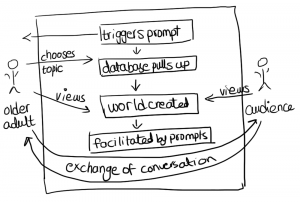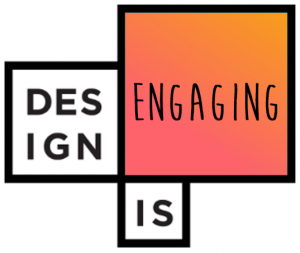VR Storytelling
Designing Virtual Reality Storytelling for Older Adults to overcome Social Isolation
Amna Azhar
Welcome to my Exhibit!

Hello! Thank you for coming to my exhibit. I am Amna, a software developer by profession. As a graduate student in Inclusive Design, I am interested in doing multidisciplinary projects for the design and development of novel software and hardware applications focused on assistive and rehabilitation technologies. My research focuses on designing an immersive experience for older adults where they are able to share their life stories and communicate with others to stay socially engaged in life.
Direct Access
- Clone the git repository.
- Check out the demo.
Introduction
Social isolation is commonly defined as a low quantity and quality of contact with others, and includes “number of contacts, feeling of belonging, fulfilling relationships, engagement with others, and quality of network members” [1]. Socially isolated persons lack social contacts, social roles and mutually rewarding relationships [2]. Older adults can suffer from social isolation due to several reasons such as their lack of mobility due to physical constraints, financial reasons or other; shrinking social network limiting to only close friends and family; and relocating to nursing homes away from family members, etc. It is important to provide opportunities where older adults can share their experiences, make connections, share cultural knowledge and oral traditions across generations, and build relationships with others in a positive and more supportive social environment. Storytelling is the oldest form of communication and conversational storytelling is known to encourage participation. My research looks into how we can leverage the engagement and immersion that VR offers and combine it with storytelling to develop a social experience for older adults to communicate and connect with others.
Motivation
Canada’s population is aging rapidly as a growing proportion of baby boomers transition into their senior years. In 2015, for the first time, the number of persons aged 65 years and older exceeded the number of children aged 0 to 14 years. At the same time, as per the report of National Seniors Council, the growth rate of the population aged 65 years and older was 3.5% – approximately four times the growth rate of the total population. Given the growing population of elderly, it is significantly important to evaluate the social impact of researching and improving the quality of life for older adults. Research shows it has a positive social impact on stakeholders and creates economic and social benefits. Happiness and wellness of adults is elemental to family members and promotes healthier relations. In a nursing home, happier residents translate to job satisfaction for staff members reflecting to fulfillment and decline in turn over. Healthy aging society means the government will see a decline in expenses on healthcare and social services for older adults.
Problem: Statistics show that as many as 43% of older adults feel socially isolated (Statistics Canada, Data 2020-2022). Social Isolation is detrimental to health. Social Isolation can lead to loneliness [3], the effects of which can result in cognitive, emotional and physical decline affecting life expectancy. [4]
The happiness and health of older adults means successful aging of older adults. Successful aging is characterized by three components as shown in Figure A (Rowe & Kahn, 1987) [5]. Table 1 shows how social isolation affects all three characteristics of successful aging:

| Minimize risk of disease & disability | Social isolation will lead to increased risk of Alzheimer’s, dementia etc. [6] |
| Active engagement with life | Social isolation leading to loneliness prevents individuals from engaging in conversation with people and have a positive outlook on life. They feel cut off from the world. [7] |
| Maintain physical and cognitive function | Social Isolation and loneliness can deter physical and cognitive stimulation by inducing depression. Depression is associated with lower rates of exercise and worse nutrition. [8][9] |
Table 1
Design & Tools:
Storytelling:
One way to overcome social isolation is by communicating. Communication through conversational storytelling is more participatory in nature and fulfills the psychological needs of being heard and listened to for older adults. [10] Being able to share experiences and communicate through storytelling means older adults relive past experiences that make them happy. Storytelling connects families that are living apart when grandparents pass down cultural knowledge in the form of narratives to their grandchildren which is proven beneficial for inter-generational bonding. Additionally, individuals feel good about themselves when they identify with the positive self-image they project in their stories. [11]
Storytelling may prove to be harmful when they are not facilitated.
Virtual Reality:
Virtual Reality (VR) is the use of computer technology to create a simulated environment which can be explored in 360 degrees. VR offers ‘safe’ immersion and presents realistic 3D perceivable experience. VR environments can be used to simulate interactive worlds full of gamified, engaging content. [12]
It is important to keep in mind that too much use of VR may cause cyber sickness, eye strain, and headaches, neck pain. Some visualizations can be startling.
The Idea:
Keeping in mind VR and conversational story [13] design guidelines, with the exploratory research done so far, the steps below describe my system’s design:
- User (older adult) goes in Virtual Reality.
- System prompts user to recall a memory through story prompts such as “Who” “What” “When” “Where”.
- User talks about a place or event.
- System Database pulls up sets of images or videos in 3D for user to go inside virtually.
- User takes hold of the narrative eg: “I visited Brazil back in …”.
- System can give optional conversational prompts “What did you explore?”
- Audience get to experience, listen, ask questions, share their own experiences.

Prototype/Activity:
For the sake of rapid prototyping, I found out from my research that an effective story can be as short as 2-3 minutes in length and told in the first person, about a person, event or issue the narrator feels strongly about. The digital storytelling process typically recognizes many elements of storytelling, including the oral tradition, the writing process, the power of visuals, and the role of digital media in recording and sharing stories.
In the building of this prototype, I found the following questions helpful to answer in order to shape my idea better:
1) Identifying a place that will be the subject of the story.
Choosing a realistic hangout place such as a living room serves to “anchor” the story in a physical way.
2) Identify an audience for the story.
I am targeting a general audience and using visuals, contrasts, and audio to keep accessibility in consideration.
3) Identify a purpose for the story.
The purpose of the story is to create empathy for the audience to feel connected with the user’s life. Some of the variables that should be evaluated from the participation of the audience are:
Engagement: The incentive to look around, observe and spend time in the space.
Interaction: The user-friendliness of the interaction.
Communication: The meaningful connection made with the other person from the social experience.
Following is a preliminary prototype of how a 3D social experience can look like from the audience’s point of view. The example simulates a hypothetical living room of our target user who is the older adult. The idea is to understand and interact with the virtual space of the older adult. VR allows you to feel fully immersed and gives a more realistic sense of presence. In this type of framework, the audience can look around and navigate freely in this virtual space of our user to learn more about their life. Even though in this prototype the user is an automated humanoid, the real design will have an actual older adult, depicted by their 3D model, who will communicate with their audience in real time wearing VR headsets. Therefore, anyone who enters will share the same virtual space to explore.
Clone the git repository here.
Discussion & Feedback:
If you tried out the experience, let me know your thoughts on the exhibit in the Q&A session or reach me on email at amna.azhar@sudent.ocadu.ca. Thank you for your time!
References:
- Nicholas R. & Nicholson Jr. (2008). Social isolation in older adults: an evolutionary concept
analysis. Journal of Advanced Nursing. 65(6), 1342-1352. - North Sky Consulting Group Ltd. (2013). Removing Barriers to Social Isolation. City of Nanaimo
the Harbour City. - Courtin E, Knapp M. (2017). Social isolation, loneliness and health in old age: a scoping review. Health Soc Care Community, 25(3): 799–812.
- Kelly, Michelle E., et al. “The impact of social activities, social networks, social support and social relationships on the cognitive functioning of healthy older adults: a systematic review.” Systematic reviews 6.1 (2017): 259.
- Rowe, John W., and Robert L. Kahn. “Human aging: usual and successful.” Science 237.4811 (1987): 143-149.
- Wilson RS, Krueger KR, Arnold SE. Loneliness and risk of Alzheimer disease. Arch Gen Psychiatry. 2007; 64:234–240.
- Taylor MG, Lynch SM. Trajectories of impairment, social support, and depressive symptoms in later life. J Gerontol B Psychol Sci Soc Sci. 2004;59:S238–S246.
- O’Hara R. Stress, aging, and mental health. Am J Geriatr Psychiatry. 2006;14:295–298.
- Emerging Technologies to Support an Aging Population. www.whitehouse.gov/wp-content/uploads/2019/03/Emerging-Tech-to-Support-Aging-2019.pdf.
- Hausknecht, S., Vanchu-Orosco, M., & Kaufman, D. (2017). Sharing Life Stories: Design and Evaluation of a Digital Storytelling Workshop for Older Adults. Communications in Computer and Information Science Computers Supported Education, 497–512. doi: 10.1007/978-3-319-63184-4_26
- Poulios, Apostolos. “The construction of elderly identity through conversational narrative.” Selected papers on theoretical and applied linguistics 16 (2005): 279-295.
- Lin, X. X. C. (2017). Designing Virtual Reality (VR) experience for older adults and determine its impact on their overall well-being (Doctoral dissertation, Massachusetts Institute of Technology).
- Norrick, Neal R. “Conversational storytelling.” The Cambridge companion to narrative (2007): 127-141.
abusive or other inappropriate content
free from physical constraints



Feedback/Errata